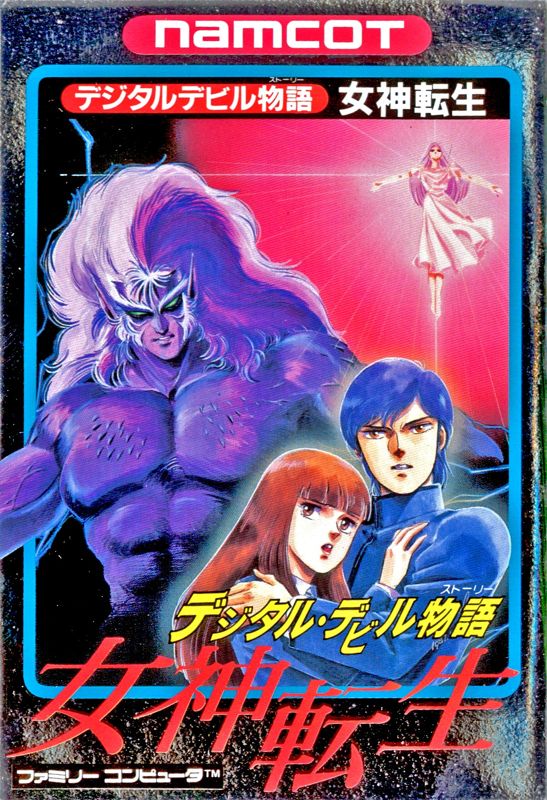Retro Replay Review
Gameplay
Digital Devil Story: Megami Tensei offers a fresh spin on the early RPG formula by placing you directly into sprawling, maze-like dungeons rendered in a first-person perspective. As Akemi Nakajima and Yumiko Shirasagi, you’ll navigate grid-based corridors, search for hidden doors, avoid traps, and scavenge for magnetite—the vital energy source your summoned demons consume. Movement, map-making, and resource management become critical skills as you plunge deeper into the earth and confront ever-deadlier fiends.
(HEY YOU!! We hope you enjoy! We try not to run ads. So basically, this is a very expensive hobby running this site. Please consider joining us for updates, forums, and more. Network w/ us to make some cash or friends while retro gaming, and you can win some free retro games for posting. Okay, carry on 👍)
The game’s turn-based battles demand tactical choices far beyond simple “attack or magic.” Encounters with demons often give you the chance to parley instead of fight: offer them yen or magnetite, gauge their alignment against the current phase of the moon, and attempt to recruit them to your cause. Successful negotiations expand your roster, letting you tailor your party’s strengths around elemental affinities and resistances.
Beyond recruitment, Demon Fusion provides another layer of depth. At special facilities you can combine two captured demons into a wholly new species, inheriting abilities and sometimes obtaining rare spells. Experimenting with Fusion charts encourages replayability and gives dedicated players a powerful incentive to revisit earlier levels armed with knowledge of which combinations yield the most potent allies.
Character growth is in your hands: each time Nakajima or Yumiko levels up, you decide precisely which stats to boost. Whether you specialize in physical prowess, magical aptitude, or endurance, your choices shape how you approach every dungeon expedition. This manual allocation system rewards forward planning and allows for wildly different playstyles—even challenging the game’s difficulty curve in creative ways.
Graphics
For a title released on the Famicom in 1987, Digital Devil Story: Megami Tensei’s visuals strike an effective balance between functionality and atmosphere. The first-person dungeon walls are simple and repetitive, but their stark, grid-based design heightens the feeling of claustrophobia and disorientation. Limited color palettes and minimalist textures contribute to the sense that something sinister lurks around every corner.
Enemy sprites and demon portraits manage to convey personality despite hardware constraints. From skittering low-level imps to fearsome bosses, each design stands out with distinctive silhouettes and expressive, often grotesque, facial features. These static images, seen before every battle, heighten the tension and accentuate the horror-novel origins of the source material.
The user interface is austere by modern standards: text windows, simple status bars, and numeric readouts for HP, MP, and magnetite. Yet this no-frills presentation serves the game well, keeping your focus on exploration and negotiation rather than flashy animations. Occasional background music and sound effects underscore demon communications and dungeon hazards, adding another layer of immersion without overwhelming the senses.
Story
At its core, Megami Tensei tells the tale of Akemi Nakajima, a brilliant high-school programmer who unleashes chaos when a bully provokes him. With his Devil Summoning Program, he inadvertently frees the malicious Loki, igniting a demonic invasion of Earth. The setup feels straight out of a horror novel—one that hinges on youthful pride, forbidden technology, and the thin line between scientific curiosity and unleashing eldritch evil.
Enter Yumiko Shirasagi, a poised transfer student with a mysterious interest in both Akemi and the supernatural software he’s created. Together they resolve to undo his catastrophic mistake by mastering the Devil Summoning Program for benevolent ends. Along the way, both come to question their own identities and the nature of their past incarnations—tying into themes of reincarnation and predestination that permeate the narrative.
Based on Aya Nishitani’s horror novels, the story unfolds through sparse but atmospheric dialogue, demon negotiation text, and occasional plot-driven events. There are no flashy cutscenes—just your imagination, prodded by carefully chosen words and the grotesque designs of summoned creatures. For players who appreciate an understated, cerebral tale, Megami Tensei’s narrative remains unexpectedly engaging.
Overall Experience
Digital Devil Story: Megami Tensei stands as a pioneering RPG that introduced mechanics still central to one of gaming’s longest-running franchises. Its blend of dungeon crawling, demon negotiation, and Fusion systems offers a level of strategic depth rare for its era. While the learning curve is steep and mapping paper is almost a requirement, dedicated adventurers will find satisfaction in outsmarting powerful foes and uncovering every secret corridor.
The game’s difficulty and old-school presentation may challenge modern sensibilities, but for enthusiasts of retro RPGs, it remains a rewarding journey. Every decision—from allocating stat points to choosing whether to bargain or battle—carries weight. The risk-reward cycle of demon recruitment and fusion alone provides hours of experimentation and discovery.
Ultimately, Megami Tensei’s stripped-down graphics, haunting demon art, and text-driven story combine to create an experience both nostalgic and fresh. It laid the groundwork for future entries in the franchise, and even today, players can appreciate its innovative spirit and uncompromising design. For those looking to trace RPG evolution back to its roots, or for fans of demon-summoning lore, Digital Devil Story: Megami Tensei remains an essential play.
 Retro Replay Retro Replay gaming reviews, news, emulation, geek stuff and more!
Retro Replay Retro Replay gaming reviews, news, emulation, geek stuff and more!








Reviews
There are no reviews yet.